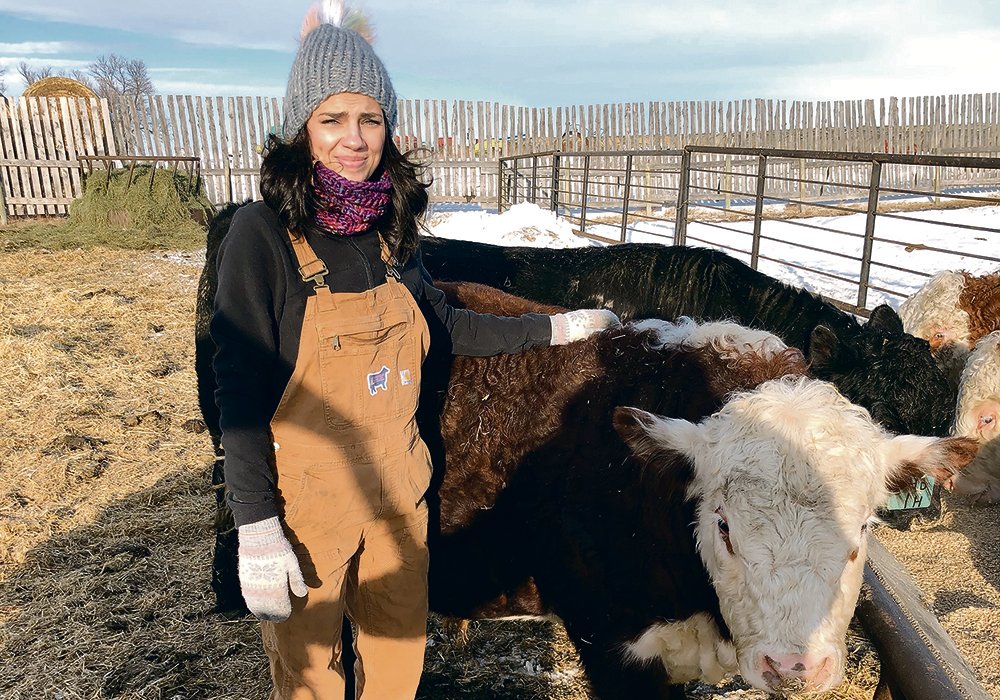Students get chance to ‘adopt’ a calf
A Saskatchewan ranch came up with the Classroom Cattle project as a way to teach young people about beef production
By Barb Glen
| 4 min read

Julie Mortenson has helped hundreds of students get to know this bull calf through the Classroom Cattle project. Photo: Supplied
More than 1,200 students in three provinces are getting regular updates on the life and times of Calfy Crisp, also known as Oreo and Big Red. The bull calf is a resident at Mortenson Farms near Nokomis, Sask.
The Classroom Cattle project is the brainchild of Julie Mortenson, who operates the farm with her husband, Logan, his brother, Adam, and his parents, Barry and Lois. Through her efforts, 1,280 students from 61 classes — 53 in Saskatchewan and four each from Alberta and Ontario — are learning about beef production.
It is the first full year of the project, which began in October and will run until May. Each class has “adopted” the bull calf, though each has given it a different name.
Mortenson provides regular updates on the animal’s progress to each teacher, who then incorporate the information where it fits in the curriculum.
“I opened the sign-up to any Canadian teacher of any grade,” said Mortenson. “I have had a wide range of classes signed up, so I have anywhere from pre-K (Kindergarten) to my oldest class this year, Grade 7-8.”
Initial feedback has been great, she said, including response to an early change in plans. She had intended to have some classes focus on a bull calf and some on a heifer, and that’s how the program started. Then the heifer died of bloat after eating an excess of alfalfa hay.
“I was bracing myself for a bit of a negative kickback for that situation to occur but I was amazed by the feedback that I got from the students and the teachers themselves. They were really impressed with the transparency and were very understanding.
“It was definitely a shock, something we didn’t want to have happen, but it was amazing, the learning curve. The kids just took it in stride. It was great for them to learn one more side of the business as well.”
Now all classes focus on the bull calf, which is destined to be raised and sold as a future herd sire.
“I thought it would be interesting to have him be assigned as my classroom cattle calf…. The students can see that side of the marketing aspects and potentially see him in the spring, towards the conclusion of the program year, see him go to be sold to a different farm and potentially start working as a herd sire at someone else’s farm.”
Mortenson’s monthly update highlights the progress of the bull calf and includes video of the farm with explanations about feed, shelter, handling equipment and other aspects of cattle production.
Her plan is to offer one on-site visit per class each year but pandemic-related restrictions put a halt to that. Now an online program is used for her updates, which she supplements by sending each class learning tools including feed samples, ear tags, bits of cow hide and other items students can see, smell and touch.
She also answers questions from students.
“I had one of the classrooms … I showed them their classroom calf up close and in person and I explained about the hoof and how (cattle) have two toes on each foot and the student was quite shocked that cattle don’t have fingers. It’s been interesting to hear what the kids come up with.”
She has also been asked to explain how to tell male from female and how the farm determines which animals are kept for breeding and which ones become beef.
Questions like that reinforce Mortenson’s original goal.
“When I was on maternity leave with my first daughter, I took on the role of being the playschool teacher for our town, just to do something once a week to keep me busy. And I was surprised at how little the kids in my own small rural community knew about where their food comes from and how livestock are raised.”
She decided to do something about it, devising the idea and initially contacting teachers in her community. Sign-up by teachers spread from there, with most of them in rural communities.
“I think as word gets out about it, I might see more of an uptick in the urban centres, looking for a program like this,” she said.
Calfy Crisp/Oreo/Big Red, who was a baby in May, now weighs more than 1,000 pounds, a growth rate that has also intrigued the students.
“The ones that are most enthused by it have been Grade 3 and under. I think Grade 3 is kind of the sweet spot… I wouldn’t discount the fact that there’s older kids in the program learning from it, but they’re not as enthusiastic about it,” said Mortenson.
She and Logan have two children under the age of three but she is managing the program on her own with recent advice from Ag in the Classroom.
She also has a three-year grant from the federal-provincial Canadian Agricultural Partnership, which means she will be running the program for at least another two years. The Saskatchewan Cattlemen’s Association is also providing support.
Mortenson Farms has 250 commercial cattle and 50 purebred registered Herefords. The family also farms about 5,000 acres of owned and rented land.
Sign-up for the next year of Classroom Cattle will open in September.
More information is available at mortensonfarms.ca/classroom-cattle and on Instagram at @classroomcattle.
This article was originally published at The Western Producer.


